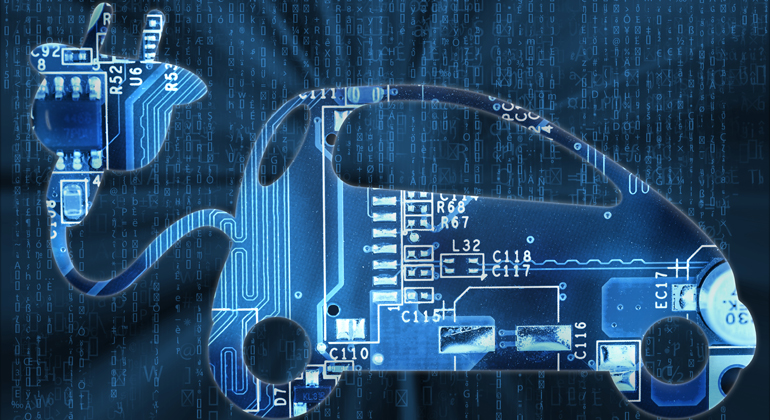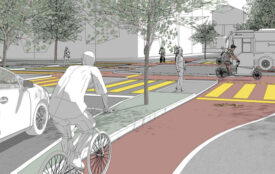A supercomputer on wheels
Modern cars are packed full of electronics. Managing all the computers and assistance systems is a complex task, and the cable harnesses increase the weight of the car.
In the joint research project CeCaS, Fraunhofer researchers are working on a systems architecture based on the idea of managing all electronic components centrally from one computer platform. This will make it easier to construct highly automated, connected vehicles. The core element of this Fraunhofer technology is an extremely reliable Ethernet backbone that works in real time.

Imagine a car with components that are controlled from a central supercomputing platform instead of by dozens of intricately interconnected computer systems; you could easily install updates via Wi-Fi without going to a mechanic, and integrate new functions as needed. This is the vision that the Fraunhofer Institute for Photonic Microsystems IPMS and partners from the automotive industry are working toward as part of a joint research project, CeCaS (Central Car Server — Supercomputing for Automotive). The goal is to remodel the computer architecture used in cars from the ground up so that it is fit to meet the high demands associated with automated, connected vehicles. The idea is to turn cars into supercomputers on wheels, where the components can communicate with each other in real time. The German federal government is supporting the project as part of its initiative for funding research on electronics and software development methods for the digitalization of automobility (MANNHEIM).
There is an urgent need for a new computer architecture in cars. Trends such as automation and connectedness are increasing data volumes in cars enormously. This is why vehicle manufacturers are looking for solutions that will allow them to standardize vehicle technologies, manage all components via a central instance, optimize communication between systems and provide the required computing power in real time.
Real-time Ethernet for cars
The Dresden-based Fraunhofer researchers are focusing on Time-Sensitive Networking (TSN) for their project. In order to be able to harness this technology, the team is further developing its tried-and-tested functional blocks for semiconductors, called IP cores. The aim is to equip the Ethernet-based network technology with real-time capabilities while making it robust and extremely reliable in all situations. “TSN achieves this combination of real-time capability and reliability through means such as using a consistent system time for all relevant control devices, using a smart system for managing process queues and by prioritizing tasks,” explains says Dr. Frank Deicke, head of Data Communication and Computing. This means commands that go to the brake system are, of course, assigned a higher priority than commands being sent to the air conditioning. Despite the enormous volume of data that a vehicle generates every second, the majority of which needs to be processed in real time, CeCaS systems are robust and extremely reliable.
Ethernet also brings other advantages to the project. “The fundamental advantage of Ethernet is that it is both very flexible and highly scalable. When combined with our IP cores, this technology can easily be adapted for use with vehicles of different sizes, performance categories and functions,” says Dr. Deicke.
Fewer cables for a lighter car
The benefits of architecture models like the one being developed in CeCaS do not stop there. Ideally, they will make it possible to update cars without taking them to a mechanic. Instead, the cars will be updated via Wi-Fi, almost like a laptop or desktop PC. “If you needed to, you could also integrate new functionalities that way,” says Dr. Deicke. The central control system will also require a narrower cable harness, which will reduce the amount of materials used in manufacturing, and thus lower costs — and make the car significantly lighter overall.
In this development work, the Fraunhofer experts can draw on their many years of experience in the areas of chip programming, network technology, and hardware and software co-design.
From domain management to zone management
The computer architecture being developed in the CeCaS project for the car of the future represents a radical departure from current construction methods: from domain-based control of components to zone-based management, where just a few high-performance computing platforms control many modules simultaneously. These include safety-critical systems such as the engine, gearbox and brakes as well as dash cams, parking aids, temperature and proximity sensors, motors for electric windows and seat adjusters, air conditioning and on-board entertainment systems.
For the automotive industry, this project funded by the German federal government will not only be a key factor in improving vehicle performance and reducing costs: It will also play a critical role in maintaining and expanding German car manufacturers’ technological sovereignty and independence.
- Fraunhofer Institute for Photonic Microsystems (ipms.fraunhofer.de)








